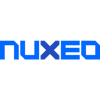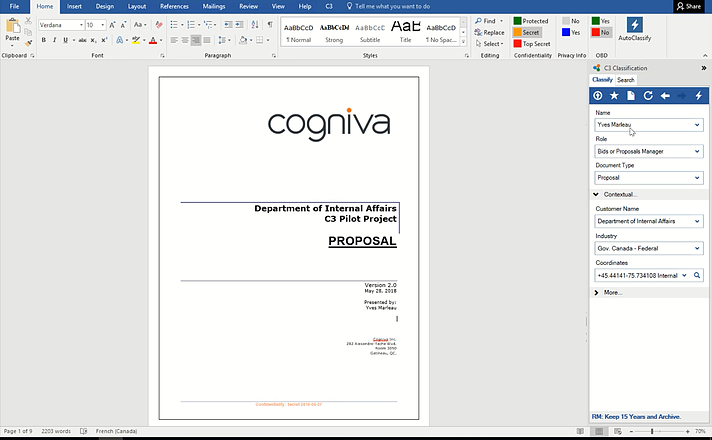The C3 platform unifies traditional IM tools and policies into one consistent framework, simplifying information management tasks for users while dramatically improving compliance, governance, and retention measures across your information landscape.

C3 integrates directly with Microsoft 365 and the Office desktop applications, including Outlook, allowing users to automatically tag and route their content to the correct location, while automatically assigning the appropriate access permissions and sensitivity/retention labels.

C3 connects to both online and on-premises versions of SharePoint and supports the synchronization of C3 multilingual metadata into the Term Store. The C3 Classifier integrates seamlessly with SharePoint Managed Metadata and Azure Information Protection Labels.

Simplify the end-user experience for Content Server with automating your user's tasks, including classification, permissions and records assignment, and routing to the correct location.

C3 seamlessly integrates with Azure Information Protection Labels, automatically applying labels based on the metadata determined by the C3 Classifier.

The integration of C3 with Nuxeo allows users to automatically route their documents to Nuxeo locations using all of the power of the C3 automatic classification directly from Office applications.
It is possible to save content tagged by the C3 Classifier, search for content already tagged, or retrieve content to be tagged directly to/from any repository compatible with the CMIS standard.
Acropolis, Alfresco, Apache Chemistry InMemory Server, Ceyoniq Technology, calvaDrive, Cincom, Day Software CRX, dotCMS, Eyebase mediasuite, EMC Documentum, eXo Platform, Content Manager, IBM Content Manager On Demand, IBM Connections Files, IBM LotusLive , IBM Lotus Quickr, ISIS Papyrus Objects, KnowledgeTree, LogicalDOC, Maarch, Magnolia (CMS), Microsoft SharePoint Server, NemakiWare, Nuxeo, O3Spaces, OpenCms, OpenKM, OpenText Content Suite, OpenWGA, Oracle Webcenter, PTC Windchill, Star Storage, and Surround SCM.

The C3 Office Classifier is designed to automate tagging and classification tasks directly within the Microsoft Office Suite of products. Users can access all of C3's automatic classification directly from the applications they use every day (Word, PowerPoint, Excel, and Outlook) whether Online or on the Office desktop clients, including automatic classification, compliance, and routing capabilities. The C3 Office Classifier can detect sensitive and private information within the documents and ensure that the appropriate IM rules are applied, including the location the document should be saved.
With C3, users can route their content to the correct location across any of the compatible C3 connectors, whether for SharePoint, Content Server, Documentum, or any of the 35+ other ECMs that support the CMIS standard. Save users from the burden of deciding on the correct save location, security designation, and permissions that should assigned to content while ensuring consistent application of your Information Governance policies. The pre-set location rules are defined by combinations of metadata values that have been applied to the document either manually or automatically. The target destination can be an absolute value, or can be defined by the metadata discovered by the C3 Classifier. The C3 content router can be connected to multiple repositories at the same time, allowing content to be routed to different repositories, e.g. financial documents can be routed to specific folders in Documentum while contractual documents are routed to a network drive location.
Over 35 Other ECMs + C3
It is possible to save content tagged by the C3 Classifier, search for content already tagged, or retrieve content to be tagged directly to/from any repository compatible with the CMIS standard, including the following:
Acropolis, Alfresco, Apache Chemistry InMemory Server, Ceyoniq Technology, calvaDrive, Cincom, Day Software CRX, dotCMS, Eyebase mediasuite, EMC Documentum, eXo Platform, Content Manager, IBM Content Manager On Demand, IBM Connections Files, IBM LotusLive , IBM Lotus Quickr, ISIS Papyrus Objects, KnowledgeTree, LogicalDOC, Maarch, Magnolia (CMS), Microsoft SharePoint Server, NemakiWare, Nuxeo, O3Spaces, OpenCms, OpenKM, OpenText Content Suite, OpenWGA, Oracle Webcenter, PTC Windchill, Star Storage, and Surround SCM.
SharePoint delivers effective information governance through a blend of technology and Information Management components. However, even with the newly released automatic classification abilities included with Azure Information Protection and SharePoint Syntex, there are still some major gaps in SharePoint's Information Governance capabilities. C3 fills the Information Governance gaps in SharePoint through its C3 for SharePoint Connector, integration with AIP Labels, and Term Store metadata synchronization. C3 augments SharePoint's automatic classification by capturing the relevant business context of information, enhancing the richness of metadata using semantic relationships driven by the C3 model. C3 brings together the processing of the content of the document with the contextual information automatically derived by the C3 Classifier. With C3, organizations can ensure that their metadata is synchronized to the Term Store, and automatically applied by the C3 classifier, including AIP Labels, content routing, and access rights.
For Canadian Federal Government departments, download the PDF below for more information on how Cogniva's C3 can enhance the uptake of GCDOCS.

C3 augments the automation classification provided by AIP Labels by incorporating business context into the automatic classification processing. This allows the classification process to combine the content of the document with the organization purpose of a document, allowing more accurate and semantically informed automatic classification of metadata values, AIP Labels, permissions assignment, and content routing.
Introduction to C3 for Shared Drives:
C3 works seamlessly with corporate file shares. Once classified with C3, document and email metadata will be stored within the file container of the directory structure. This metadata is protected and inaccessible to users other than through the C3 interface. As the metadata structure is identical for any repository supported by C3, the C3 Shared Drive Integration is ideal for environments where an ECM system is either not available or not yet implemented. Once the ECM system is deployed, information can be migrated seamlessly from network drives to the new system.
20 Allée de Hambourg
Bureau 220
Gatineau, QC J9J 4K3
Sales and Technical Support:
Sales: sales@cogniva.ca
IT Support: support@cogniva.ca
Copyright © 2018 Struto. All rights reserved. Terms and Conditions & Online Privacy